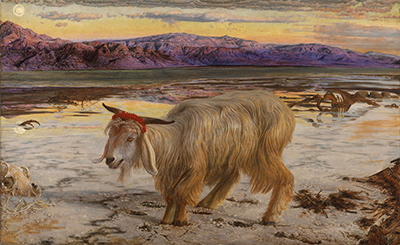The Scapegoat is a painting by artist William Holman Hunt, who along with Dante Gabriel Rossetti and John Everett Millais formed the Pre-Raphaelite group in 1848.
The painting was completed in 1855 after Holman Hunt had travelled extensively in the Middle East and draws heavily on the Pre-Raphaelite's love of religious art from the Renaissance period.
In 1854 Holman Hunt travelled first to Jerusalem and then on to Oosdoom, near the southern shores of the Dead Sea. Here, he made many landscape sketches and bought a rare mountain goat to use as the model for The Scapegoat.
This goat was not a good model as it was difficult to keep it still and the creature soon died. A second goat was bought and put through rigorous posing, often in trays of dirt to capture an idea of the natural landscape.
The painting is noted for its strong colours and skilful depiction of light and shade. The intensity of the colours was created by mixing the oil paints with copal varnish and applying the mixture in thin glazes.
The painting style is considered to be reminiscent of stained glass windows. Holman Hunt used pigments that had only just been discovered, including madder and a deep blue which is either ultramarine or cobalt.
William Holman Hunt also designed the painting's heavy gold frame, which features biblical inscriptions and intricate carving of religious iconography including doves. He considered the frame essential to people's understanding of the painting, which is based on a story from Leviticus.
The painting was criticised upon first display at the Royal Academy in 1856 as people were not used to this style. One critic remarked that without the title of The Scapegoat, it would have been impossible to know what the piece represented.
The Pre-Raphaelite group were considered highly rebellious and their work was often ridiculed by art critics. Today, the piece is among Holman Hunt's most popular.
The Scapegoat hangs in the Lady Lever Gallery in the British city of Liverpool. A smaller, earlier version featuring darker colours and a rainbow hangs in a Manchester gallery.




